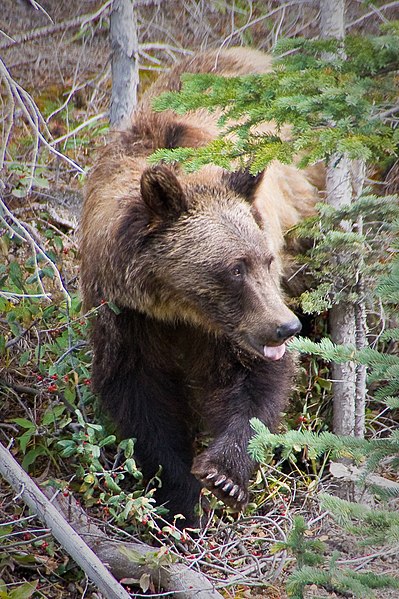Grizzly Bear Facts for Kids
The grizzly bear, also known as the North American brown bear, is a powerful and iconic species found in North America, recognized for its impressive size and distinct features.
View Article For:

Related Articles
Introduction
Their fur ranges from blond to dark brown, often with a lighter-colored “grizzled” appearance that gives them their name. Grizzlies are both strong and fast, capable of running up to 30 miles per hour (48 km/h)! They are usually solitary animals, except during the mating season or when mothers raise their cubs. 🌲
Fun Facts
They can sprint at 30 miles per hour! Also, their sense of smell is about seven times stronger than that of a bloodhound! 🐕
Grizzlies can weigh up to 1,500 pounds, making some of them heavier than a car! 🚗
Local legends say that grizzlies can climb trees even when fully grown, which is true for younger bears but harder for larger adults. So don’t be surprised if you see a bear on the move in the forests and mountains! 🌲
Social Behavior
Although they can be territorial, they often avoid fights with other bears and prefer to communicate through body language like growls or huffs. When two grizzlies encounter each other, they may stand tall to assess each other without conflict. Cubs learn from their mothers how to interact with others and recognize danger. 🐻
It's fascinating how these huge creatures manage their social relationships while living mostly alone!
Conservation Status
️ They are protected in many areas, like Yellowstone National Park and Glacier National Park. Laws help to keep these animals safe, preventing hunting and disturbing their habitat. However, as cities expand and roads are built, grizzlies need more protection. Conservationists are working hard to ensure that these amazing creatures continue to thrive in their natural homes. 🌎
Cultural Significance
Various tribes have stories and legends about grizzlies, describing them as powerful spiritual guides or protectors. Today, they are popular in literature and movies, like “The Revenant” and “Brother Bear.” 🐾 The bear also appears in many emblems and logos, representing wildness and freedom. People love visiting national parks like Yellowstone to see these incredible animals in person, highlighting their importance to both nature and culture. 🎨
Subspecies Variations
️ Another subspecies is the Mexican grizzly bear, sadly now extinct. The Sierra Nevada grizzly bear was another variety that lived in California. Each subspecies has adapted to its unique environment, showing just how incredible and varying these animals can be! 🦶
Understanding these differences helps researchers protect each type of bear and their habitats better. 🌳
Habitat And Distribution
They prefer habitats like forests, mountains, and alpine regions. Grizzlies like areas near rivers and lakes, as these spots provide food and water. They need plenty of space to roam, as adult grizzlies can have territories that cover over 1,000 square miles. 🗺
️ The more remote the area, the more likely you are to encounter a grizzly! Protecting their natural habitat is essential for their survival.
Interactions With Humans
It’s important for people to understand how to coexist with bears safely. Carrying bear spray, making noise on trails, and keeping food secure can help prevent conflicts. 🥗
In some regions, people learn to watch bears from a distance to appreciate them while keeping safe. Learning about grizzlies helps us protect them, ensuring they remain part of our ecosystem for years to come! 🏞
️
Physical Characteristics
Grizzlies can also live for about 20 to 25 years in the wild, but some can live even longer in captivity! Their sharp teeth are adapted for different foods. For example, they have flat molars for grinding plants, and sharp canines for catching fish! The grizzly bear’s keen sense of smell is amazing; they can smell food from over a mile away! 👃
Diet And Feeding Behavior
Grizzly bears are known to forage for food intensely, eating up to 100 pounds of food in a single day. That’s a lot of food! 🍽
️
Reproduction And Lifecycle
️ The cubs grow quickly, gaining weight as they prepare for their life outside the den, starting to venture out in spring.
DIY is a humongous library of
activities and courses for kids.
Curious?
Gallery of
Did you know?
🐻 Grizzly bears are known scientifically as Ursus arctos horribilis.
🏋️♂️ They can weigh between 300 to 1,500 pounds and stand 3 to 5 feet tall at the shoulder.
🏃♂️ Grizzlies can run up to 30 miles per hour, which is as fast as a racehorse!
🌲 Their fur can range from blond to dark brown, often with a 'grizzled' appearance.
👶 Grizzly bear cubs weigh about a pound at birth and rely on their mothers for warmth and food.
🐟 During summer, grizzlies catch salmon as they swim upstream to spawn.
🌍 They primarily live in Canada and Alaska, but also in parts of the northwestern United States.
🌱 Grizzly bears are omnivores and eat both plants and animals, foraging for up to 100 pounds of food daily.
🔍 Grizzlies can smell food from over a mile away with their amazing sense of smell.
🗺️ Adult grizzlies can have territories that cover over 1,000 square miles.









